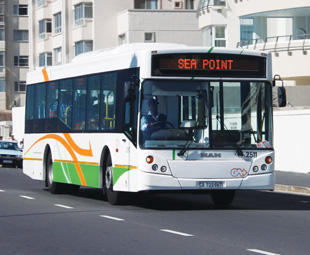How things are done down in Cape Town

With the recent expansion of FOCUS into the Western Cape, JACO DE KLERK thought it would be great to bring you our first feature with a Capetonian twist in the form of a Q&A
Fleet management is an integral part of any operator’s daily activities … We spoke to Bronwen Dyke, public relations manager and spokesperson for Golden Arrow Bus Services (GABS), to get the lowdown on this important aspect from one of the province’s oldest and biggest bus operators.
How big is your fleet? And what challenges does its operation present?
The Golden Arrow fleet consists of 1 045 buses (972 operated by GABS and 73 by our BEE partner Sibanye).
Operating such a large fleet poses many challenges in terms of scheduling, spiralling fuel prices, manpower, traffic congestion, vandalism and increased passenger demand. But Golden Arrow is fortunate enough to have over 150 years of experience in the industry. We attribute our success in this regard to the dynamic combination of tried and tested approaches while always remaining open to innovation.
What areas do your services cover?
All our vehicles operate during peak hours, serving 1 300 routes, covering a total area of approximately 2 460 km² in metropolitan Cape Town. Simply put, Golden Arrow’s service network covers almost all the areas in the entire metropolitan area of the Mother City – stretching from Atlantis (Sibanye) in the north-west, Simon’s Town and Hout Bay in the south and as far as Somerset West in the east.
These include the high-density suburbs of Mitchell’s Plain, Blue Downs, Delft, Langa, Crossroads and Khayelitsha. Bus services are provided from depots at Montana, Woodstock, Atlantis, Philippi and Simon’s Town.
The services from Atlantis have been subcontracted to Sibanye Bus Services, a joint venture established in 2001 between Golden Arrow, Abahlobo Transport Services and Siyakhula Bus Services.
In 2013, a new company called Table Bay Rapid Transit was formed in order to operate our share of the West Coast Bus Rapid Transit system. This company’s shareholders are Golden Arrow, Abahlobo and Siyakhula.
What tracking and monitoring services and systems do you use?
All Golden Arrow buses are fitted with satellite tracking devices and all services are monitored by the Provincial Department of Transport. The information is, however, not received in real time, but is analysed post operation. The next phase of this project will introduce real time monitoring, which will be coupled to real time bus information which will be made available to the public.
At the heart of our business lies our 24-hour Operations Control Centre which has an extensive radio network. All information is digested at this centre and operational decisions are taken to ensure that commuters receive an on-time service as far as possible.
In addition to this, we also have mobile inspectors who board the buses and Small Business Unit managers who observe the service. Bus inspectors are posted at strategic points in all the corridors we service. These officials monitor bus movements and check that they are operating according to the set timetable.
Should a bus develop problems during a trip it is these officials who will know about it first and initiate the necessary response. Through this system the operating department is made aware of any problems developing in the service and is able to find immediate solutions. These may involve rerouting a bus or dispatching a new bus from the nearest depot.
What systems and products do you use to monitor the service and maintenance of your vehicles?
The service intervals of our buses are 15 000 km. The kilometres travelled by each of our vehicles are electronically tracked, with services scheduled to be done in a “window” of maximum 2 000 km before or after the 15 000 km interval. An automated report shows all overdue services.
Our vehicles are also sent to an approved testing station for Certificate of Roadworthiness on a six-monthly basis.
We use parts approved or supplied by our main vehicle supplier MAN Truck & Bus. And our fuel and lubricants are supplied and approved for our vehicles and operating conditions by Chevron.
We measure our breakdowns on a daily basis. These are then summarised according to breakdown causes on a weekly basis, to assist us with root cause analysis for improvement actions. But the reliability of our newer vehicles is helping to reduce our breakdown ratios.
However, the newer vehicles have increased the training requirements dramatically: for example, servicing new buses requires knowledge of computer-based diagnostic programmes. We have therefore had to “re-train” the employees, who were skilled on older technology vehicles, to equip them to maintain the MAN vehicles and their modern technological advancements.
What systems do you have in place to monitor the behaviour of your drivers?
We have a large mobile inspectorate, whose major task is to monitor driver behaviour. Golden Arrow has also introduced state-of-the-art technology – known as Drivecam – to monitor and improve bus driver behaviour on the road.
This system uses a small video camera mounted on the windscreen, behind the rear-view mirror, which captures sights and sounds inside and outside the bus. But it only saves the audio and video when it is triggered by abrupt and irregular driving action: such as impact, sudden braking or abnormal driving behaviour.
The recorded material is then analysed to establish what occurred and how it can be avoided in the future. The device, which has thus far been installed in 450 buses, has proven to be a useful tool in our endeavours to keep track of the quality of the service and to make interventions when necessary.
As FOCUS editor Charleen Clarke said in our weekly newsletter: “While Gauteng will always remain pivotal to the transport industry – it is, after all, the heart of the wheels game – there is no denying that the Western Cape is booming and extremely active. There are lots of major fleet operators located in this province and they are serviced by an increasing supplier base.”
And Golden Arrow is definitely one such operator, with its 150 years’ experience in managing fleets.
Published by
Focus on Transport
focusmagsa




 Big news from FOCUS on Transport + Logist
Big news from FOCUS on Transport + Logist


 !
Starting 1 April, every
!
Starting 1 April, every


 FUSO: Driving the Future of Mobile Healthc
FUSO: Driving the Future of Mobile Healthc



 A brand
A brand




 Wondering about the maximum legal load for a
Wondering about the maximum legal load for a 
 The MAN hTGX powered by a hydrogen combus
The MAN hTGX powered by a hydrogen combus

 Exciting News for South African Operators
Exciting News for South African Operators


